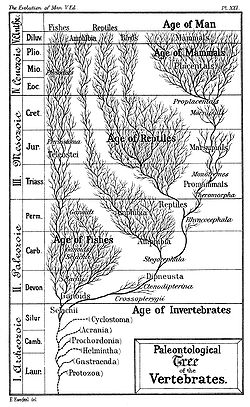the flying primate hypothesis is that megabats, a subgroup of Chiroptera (also known as flying foxes), form an evolutionary sister group of primates. The...
11 KB (1,264 words) - 23:46, 17 October 2024
Bat (redirect from Bat (Flying Mammal))
(Perissodactyla). The flying primate hypothesis proposed that when adaptations to flight are removed, megabats are allied to primates by anatomical features...
180 KB (19,210 words) - 04:14, 26 July 2025
Primates is an order of mammals, which is further divided into the strepsirrhines, which include lemurs, galagos, and lorisids; and the haplorhines, which...
162 KB (16,831 words) - 13:17, 27 July 2025
chief proponent of the flying primate hypothesis, which was based on the similarity between the brains of megabats and primates. Special emphasis was placed...
5 KB (415 words) - 00:09, 30 July 2025
Human sperm competition (redirect from Sperm competition in non-human primates)
extensively in other primates, as well as throughout much of the animal kingdom. The differing rates of sperm competition among other primates indicates that...
30 KB (3,625 words) - 14:09, 25 May 2025
Paternal care (section Non-human primates)
care arose in primate species. These include the parental care hypothesis, the mating effort hypothesis, and the maternal relief hypothesis. The parental...
59 KB (6,654 words) - 10:36, 22 June 2025
when humans dealt with rain and dew in forested primate habitats. A 2013 study supporting this hypothesis found that the wrinkled fingertips provided better...
27 KB (2,902 words) - 07:34, 20 July 2025
GAARlandia (section Hypothesis)
and the most prominent vicariance hypothesis involves colonization via GAARlandia. Proponents of the hypothesis cite studies of individual lineages...
6 KB (669 words) - 05:46, 26 May 2025
Crab-eating macaque (category Primates of Southeast Asia)
as the long-tailed macaque or cynomolgus macaque, is a cercopithecine primate native to Southeast Asia. As a synanthropic species, the crab-eating macaque...
82 KB (9,563 words) - 16:01, 10 July 2025
colugos are not lemurs; true lemurs are primates. Molecular evidence suggests that colugos are a sister group to primates; however, some mammalogists suggest...
69 KB (8,408 words) - 02:14, 12 July 2025
forelimbs of vertebrates, where the wings of bats and birds, the arms of primates, the front flippers of whales, and the forelegs of four-legged vertebrates...
40 KB (4,069 words) - 20:34, 12 May 2025
up to 24 years, but most of them die by 13 years. One of the smallest primates, the cotton-top tamarin is easily recognized by the long, white sagittal...
55 KB (6,148 words) - 17:31, 23 May 2025
group of the primates. Euarchonta and Glires together form the Euarchontoglires, one of the four eutherian clades. The current hypothesis, based on molecular...
13 KB (1,094 words) - 11:52, 29 June 2025
Homosexual behavior in animals (section Primates)
lensed through anthropocentric thinking; Bruce Bagemihl states that any hypothesis is "necessarily an account of human interpretations of these phenomena"...
109 KB (11,420 words) - 09:32, 3 July 2025
Animal sexual behaviour (redirect from Primate sexuality)
3% of mammalian species are socially monogamous, although up to 15% of primate species are. Social monogamy has also been observed in reptiles, fish,...
129 KB (14,163 words) - 20:35, 16 July 2025
Saliency Hypothesis, or V1SH (pronounced ‘vish’) is a theory about V1, the primary visual cortex (V1). It proposes that the V1 in primates creates a...
27 KB (3,198 words) - 21:58, 18 July 2025
diurnal primate species, however the ability to use auditory cues remains more similar to diurnal primate species than to nocturnal primate species....
44 KB (5,536 words) - 15:34, 26 May 2025
Oceanic dispersal (redirect from The Raft Hypothesis)
Cenozoic. Both land masses, for example, appear to have received their primates by this mechanism. According to genetic evidence, the common ancestor of...
20 KB (2,081 words) - 11:05, 24 May 2025
Timeline of human evolution (section Primates)
primitive primate skeleton", Phys.org (January 23, 2007). Alan de Queiroz, The Monkey's Voyage, Basic Books, 2014. ISBN 9780465020515 "A new primate species...
88 KB (3,543 words) - 06:23, 28 July 2025
Tool use by non-humans (redirect from Primate tool use)
non-human primates unable to develop tools beyond this zone, towards levels of human technology. According to the ZLS hypothesis, every primate possesses...
140 KB (16,845 words) - 20:35, 31 July 2025
Vocal learning (section Non-human primates)
passerine birds, non-human primates, mice, and goats, has led to the proposal of the vocal learning continuum hypothesis by Erich Jarvis and Gustavo...
66 KB (8,040 words) - 18:13, 23 July 2025
Evolution of lemurs (category Evolution of primates)
Lemurs, primates belonging to the suborder Strepsirrhini which branched off from other primates less than 63 million years ago, evolved on the island...
58 KB (6,396 words) - 09:36, 9 July 2025
Bonobo (category Primates of Africa)
critique of attempts to promote and engineer self-recognition in primates". Primates. 56 (4): 317–326. doi:10.1007/s10329-015-0488-9. hdl:2433/202619...
128 KB (13,581 words) - 14:07, 31 July 2025
2025 in paleomammalogy (section Primate research)
the primate evolution, is presented by Melchionna et al. (2025), who argue that selection for complex cognition likely drove the evolution of primate brains...
254 KB (27,373 words) - 06:52, 1 August 2025
History of HIV/AIDS (redirect from Natural transfer hypothesis)
by a human immunodeficiency virus (HIV), which originated in non-human primates in Central and West Africa. While various sub-groups of the virus acquired...
125 KB (14,958 words) - 23:37, 17 July 2025
Superior colliculus (section Primates)
This distinction between primates and non-primates has been one of the key lines of evidence in support of the flying primates theory proposed by Australian...
57 KB (7,267 words) - 10:58, 24 June 2025
H. (28 September 2007). "14: Discovery and Partial Characterization of Primate Motor-System Toxins". In Bock, Gregory; O'Connor, Maeve (eds.). Ciba Foundation...
26 KB (2,719 words) - 18:54, 17 July 2025
Taxonomy of lemurs (category Primate taxonomy)
1980s. Colugos, also incorrectly referred to as "flying lemurs", were once considered lemur-like primates, but were reclassified as close relatives of bats...
74 KB (7,072 words) - 05:01, 5 March 2025
Pierolapithecus (category Monotypic prehistoric primate genera)
Pierolapithecus catalaunicus is an extinct species of primate which lived around 12.5-13 million years ago during the Miocene in what is now Hostalets...
21 KB (2,282 words) - 23:04, 4 July 2025
























